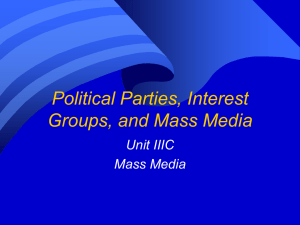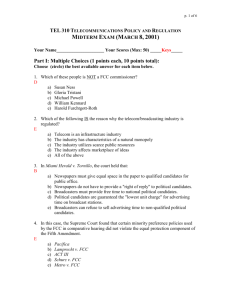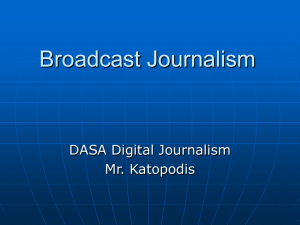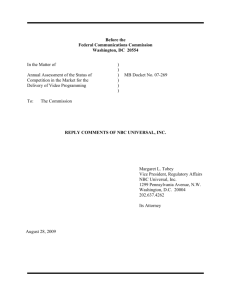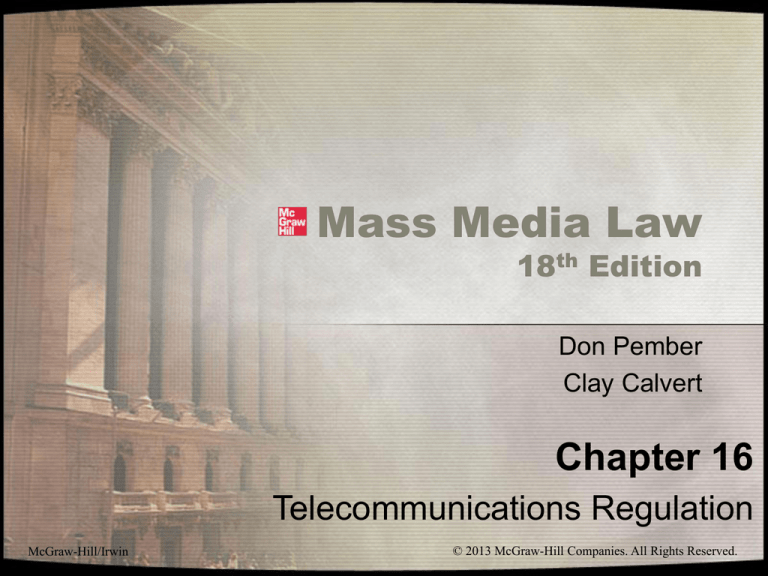
Mass Media Law
18th Edition
Don Pember
Clay Calvert
Chapter 16
Telecommunications Regulation
McGraw-Hill/Irwin
© 2013 McGraw-Hill Companies. All Rights Reserved.
Broadcast Regulation
• Changing Philosophy of Broadcast Regulation
– Broadcast spectrum is a limited transmission
pathway. Not all who want to transmit radio signals
can do so.
– Ultimately, American people own the transmission
path – the radio spectrum – through which broadcast
signals are transmitted.
16-2
Broadcast Regulation
• Changing Philosophy of Broadcast Regulation
– Broadcasters had responsibility of “meeting the public
interest, convenience, or necessity.” The acronym
PICON became the code-word to justify broadcast
regulation.
– FCC traditionally has traditionally identified three
factors promoting “public interest.” These are
competition, diversity, and localism.
16-3
Broadcast Regulation
• Changing Philosophy of Broadcast Regulation
– During the final 25 years of the 20th Century, the
notion that broadcasters should serve the public
interest began to erode.
– Rationale for broadcast regulation has unraveled as a
result of new media forms (e.g. Internet and cable
television) with theoretically limitless transmission
space.
16-4
Broadcast Regulation
• Basic Broadcast Regulation
– 1912
Radio Act
– 1927
Radio Act
– 1934
Federal Communications Act
– 1996
Telecommunications Act
16-5
Licensing
• Qualifications For Prospective Licensees
– The applicant must be a citizen of the United States
or have less than 25% foreign ownership. (An
exception was made for Rupert Murdoch.)
– The applicant must have sufficient funds to build and
operate the station for at least three months without
earning any advertising revenue.
16-6
Licensing
• Qualifications For Prospective Licensees
– The applicant must either possess or be able to hire
people who possess the technical qualifications to
operate a broadcast station.
– The applicant must be honest and open in dealing
with the commission and must have good character.
– When two or more persons seek the same license,
the FCC uses an auction process to select who will
receive the license.
16-7
Multiple Ownership Rules
• Current Rules Regulating Broadcast Ownership
– A single company or individual may own television
stations whose signals reach no more than 45
percent of the total national viewing audience.
– There is no limit on the number of radio stations any
single licensee can own.
16-8
Multiple Ownership Rules
• Current Rules Regulating Broadcast Ownership
– Ownership of both radio and television stations in a
single market is limited, based on the number of
stations in the market.
– Cross-ownership rules – the ownership of TV and
radio stations and newspapers in the same market.
• Guided by the number of media properties in a
market.
16-9
Multiple Ownership Rules
• Current Rules Regulating Broadcast Ownership
– Key federal rules related to ownership:
•
•
•
•
•
•
Television/newspaper cross-ownership ban
National television ownership rule
National radio ownership rule
Local television ownership limit
Local radio ownership limit
Dual network ban
16-10
License Renewal
• Congress has instructed the FCC to renew a
broadcaster’s license every eight years as long
as:
– The station has served the public interest,
convenience and necessity.
– The licensee has not committed any serious
violations of the Communication Act or FCC rules.
– The licensee has not committed any other violations
that, taken together, would constitute a pattern of
abuse.
16-11
License Renewal
• Public Challenges
– Though members of the public can participate in the
renewal process, citizen participation is rare in
practice.
– Recent rule changes make it harder for citizens to
mount effective license challenges.
16-12
Regulating Program Content
• FCC Sanctions
– Issue a warning notice.
– Impose a monetary fine (a “forfeiture”; an increasingly
common remedy).
– Place conditions on renewal of a broadcast license.
– Revoke a broadcaster’s license entirely (very rarely
used).
16-13
Regulating Programming
• Regulation of Children’s Programming
– Only 10.5 advertising minutes are permitted each
hour on weekends, 12 minutes each hour or
weekdays.
– At least three hours of “educational” children’s
programming must air each week.
– There must be a buffer between commercials and
program content (“We’ll be right back…).
– A program may not mention an item advertised in a
commercial for the same show.
16-14
Regulating Programming
• Should the FCC be allowed to punish
broadcasters for televising expletives?
• This is a major question that the U.S. Supreme
Court was scheduled to rule on in 2012 in a
case called FCC v. Fox Television Stations, Inc.
16-15
Regulating Programming
• FCC Definition of Indecency
– Language or material that, in context, depicts or
describes, in terms patently offensive as measured by
contemporary community standards for the broadcast
medium, sexual or excretory activities or organs.
16-16
Regulating Programming
• Three factors the FCC uses to determine if
content is offensive:
1. The explicitness or graphic nature of the description
2. Whether the material dwells on or repeats at length
descriptions of sexual or excretory organs or
activities
3. Whether the material is used to shock, titillate or
pander
16-17
Violence on Television
• V-Chip Mandate
– In 1996, Congress mandated that all manufacturers of
television sets include a V-Chip to block out violent
programming.
– Along with the chip, Congress imposed a program
rating system.
16-18
Violence on Television
• Television Ratings System
– TV – Y
approved for all children
– TV – Y7
approved for children 7 and over
– TV – G
suitable for all ages
– TV – PG
parental guidance
– TV – 14
parent strongly cautioned
– TV – M
mature audiences only
16-19
Violence on Television
• Television Ratings System: Content Ratings
– V – violence
– S – sexual situations
– L – coarse language
– D – suggestive dialogue
– FV – fantasy violence
16-20
Regulating Political
Programming
• Candidate Access Rule
– Broadcasters must allow candidates for federal office access to or
the purchase of airtime.
• CBS v. FCC (1981)
• Kennedy for President Committee v. FCC (1980)
16-21
Regulation of Political
Programming
• Equal Time Rules
– If a broadcasting station permits one legally qualified
candidate for any elective public office to use its
facilities, it must afford an equal opportunity for all
other legally qualified candidates for the same office.
– Equal time.
– Equal facilities.
– Comparable costs.
16-22
Regulation of Political
Programming
• Appearances by a Political Candidate Not
Covered By Equal Opportunity Rule:
– Appearance in a bona fide newscast.
– Appearance in a bona fide news interview show.
– Appearance in the spot news coverage of a bona fide
news event.
– Incidental appearance in a news documentary.
16-23
Regulation of Political
Programming
• Defining Legally Qualified Candidate
– Who publicly announces he or she is a candidate for
nomination or election, and
– Who meets the qualifications prescribed by law for
that office, and
– Who qualifies for a place on the ballot, and
– Who was duly nominated by a political party.
16-24
Regulation of News and
Public Affairs
• Limited Governmental Control
– The FCC has thus far rejected all complaints that
television news coverage was slanted or staged.
– The FCC has made it difficult for those who seek to
prove biased coverage to receive a remedy.
16-25
FCC and First Amendment
• Broadcasters Are Not Common Carriers
– In CBS v. National Democratic Committee (1973), the
U.S. Supreme Court gave broadcasters the right to
determine whether to air specific editorial advertising.
16-26
FCC and First Amendment
In FCC v. League of Women Voters (1984), the
U.S. Supreme Court struck down a statute that
forbade public broadcasting stations from
telecasting editorial opinions.
16-27
Regulation of New
Technology
• Satellite Radio
– Satellite radio stations are exempt from FCC’s rules
governing indecency and profanity.
16-28
Regulation of New
Technology
• Internet and Broadband
– In 2009 the FCC began developing a national
broadband plan designed to ensure that every
American has access to broadband capability
16-29
Cable Television Regulation
• Cable Television Consumer Protection and
Competition Act (1992)
– Local governments are given the primary
responsibility to regulate cable systems in their
communities.
– Local governments may issue franchises, collect
franchise fees, and renew franchises.
– Includes provisions to protect subscribers’ right to
privacy.
16-30
Cable Television Regulation
• Must Carry Rules
– According to “must carry rules,” cable television
systems must carry local television programming
channels.
– In Turner Broadcasting System, Inc. v. FCC (1994),
the U.S. Supreme Court ruled must carry rules were
constitutional.
16-31


